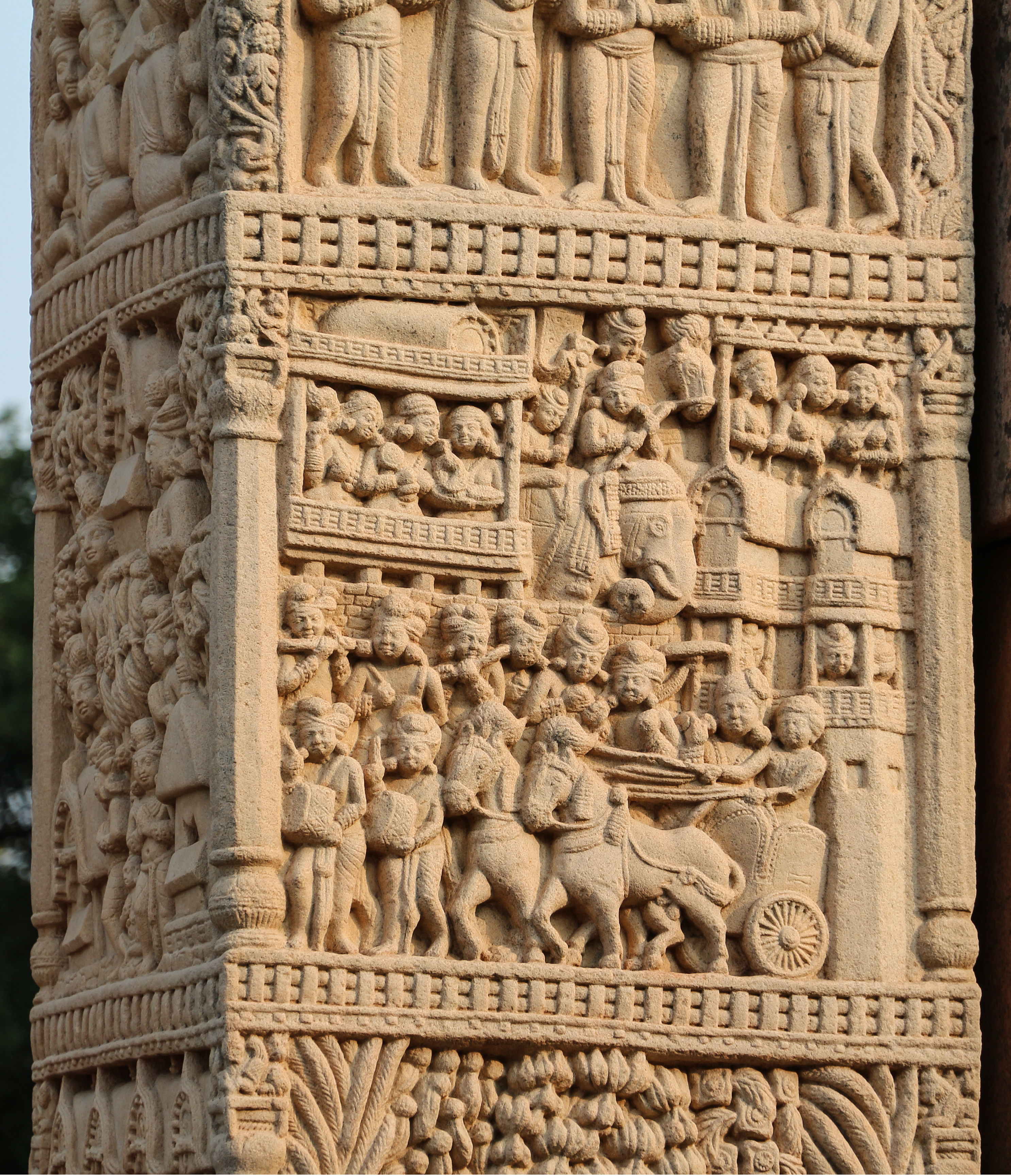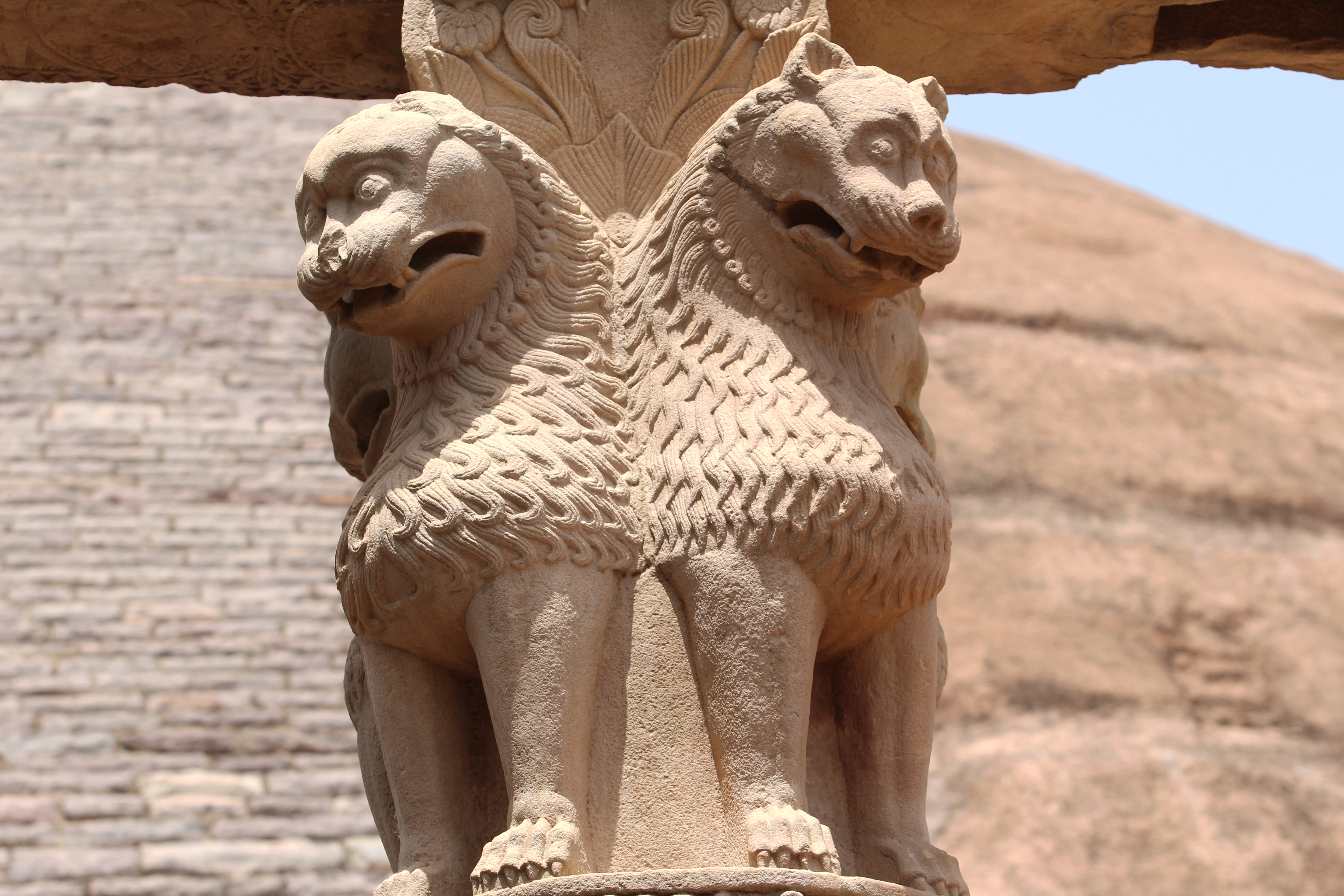 |
| Great Budhha Sanchi Stupa Suyash Dwivedi, CC BY-SA 4.0, via Wikimedia Commons |
Perched on a forested plateau in Madhya Pradesh, about 40 kilometres north-east of Bhopal, lies Sanchi, one of India’s most ancient and sacred Buddhist sites.
Its monuments, stupas, temples, viharas (monasteries), pillars, and gateways chronicle over a millennium of Buddhist art and spirituality.
Sanchi was rediscovered in 1818 after lying abandoned for centuries and now is a UNESCO World Heritage Site.
Historical Origins
Sanchi’s story begins in the 3rd century BCE when Emperor Ashoka of the Maurya dynasty, having embraced Buddhism after the Kalinga War, commissioned the construction of the Great Stupa (Stupa No. 1) to house relics of the Buddha.
 |
| Stupa 1, Sanchi Bernard Gagnon, CC BY-SA 3.0, via Wikimedia Commons |
Over the centuries, successive dynasties—Shunga, Satavahana, Kushana, Gupta, and later local rulers—added to, embellished, repaired, and expanded the complex.
Religiously, Sanchi has deep significance. Although Gautama Buddha himself never visited this site, relics of his disciples are believed to have been enshrined here.
If any tourists need any help, here is the official website of the Government of India to guide the domestic and foreign tourists: India Tourism Development Corporation (ITDC)
| East Gateway - Stupa 1 Biswarup Ganguly, CC BY 3.0, via Wikimedia Commons |
It also reflects the transition and diversity within Buddhism—from earlier or “Hinayana” phases to later “Mahayana” or devotional ones—as witnessed in its art, iconography, and temple forms.
The carvings at Sanchi serve not just decorative purposes but tell stories (Jataka tales: previous births of the Buddha; life events; miracles) and express Buddhist philosophical concepts through aniconic symbols (such as Bodhi tree, empty throne, footprints) especially in early periods.
Religion, art, politics, and royal patronage converge in Sanchi’s monuments.
Architectural Wonders: Seven Must-Visit Spots in Sanchi
When you come to Sanchi, there are certain places you simply must see to appreciate the full breadth of its religious, historic, and architectural richness. Here are at least seven, with descriptions and what makes each special.
| # | Spot | |||
|---|---|---|---|---|
| 1. The Great Stupa (Stupa No. 1) | This is the heart of Sanchi. Originally built by Ashoka in the 3rd century BCE; later enlarged, decorated, enclosed by railings, and topped by a chhatra (umbrella) representing spiritual protection. The four toranas (gateways) in the cardinal directions are elaborately carved; the railings illustrate motifs, symbols and tales. Its large hemispherical dome (anda) is symbolic of the cosmic mountain and the enclosure and path around it enable pradakshina (circumambulation)—important in Buddhist ritual practice. | |||
| 2. Stupa No. 2 | Located lower down on the hill from Stupa 1. It is among the oldest stupas in the complex and is important for the decorative reliefs on its railing and for showing early forms of Buddhist architectural ornamentation. Though it lacks the gateways of the Great Stupa, its medallions, vedika (railing), and the design reflect rich craftsmanship. | |||
| 3. Stupa No. 3 | Very close to the Great Stupa. This one is especially important for its religious relics: it is believed to have housed remains of two of Buddha’s chief disciples, Sariputra and Maudgalyayana. It also has a harmonious design and helps complete the symmetrical and ritual setting of the hilltop complex. | |||
| 4. Temple No. 17 (Gupta Temple) | Dating to around the 5th century CE (Gupta period), Temple 17 is one of the earliest free-standing devotional temples at Sanchi. Though modest in size, its proportions, layout, and decorative pillars show early temple design evolution. It has a flat-roofed sanctum, a porch (portico) supported by pillars, and carvings on the capitals (including lions). Visiting Temple 17 lets you see how Buddhist temples started becoming more “temple-like” (in contrast to stupas) and prefiguring later Hindu temples. | |||
| 5. Temple No. 18 | Near Temple 17, this is a chaitya-hall style temple (chaitya is a prayer hall, usually with apsidal end). It shows apsidal plan, pillars (12 originally, nine survive), and is built on earlier foundations from Mauryan or Sunga periods, but later remodeled in 7th century CE. The pillars are tall, and the base of Temple 18 gives a sense of how Buddhist assembly/ritual halls functioned. | |||
| 6. Monasteries (Viharas), e.g. Monastery 45, Monastery 47, Monastery 51 | These viharas show the monastic living quarters of Buddhist monks. Monastery 45 & 47 are at the eastern edge of the hilltop, offering good views; Monastery 51 is somewhat down the slope on the western side. They are arranged with a central courtyard and cells around for meditation, study and communal living. Observing them gives insight into how monks lived, how the religious community was structured, and how the architecture served both ritual and daily life. | |||
| 7. Ashoka Pillar (Pillar No. 10) and other Free-standing Pillars |
The polished sandstone column, inscriptions in Brahmi script, and the capitals (often with lion-motifs) reflect royal patronage, Ashoka’s edicts, and Greco-Buddhist artistic influences. Other pillars — such as Pillar 25 or Pillar 35 — show the evolution of pillar architecture through centuries. |
Besides these seven, there are more to explore: votive stupas (smaller stupas around the main ones), the Sanchi Archaeological Museum, The Great Bowl (a massive stone bowl used by monks), gateways (toranas) like the Eastern, Southern, Northern, Western Gateways around Stupa 1 each richly carved, and Temple No. 31, Temple 40 etc.
How Architecture Reflects Religious Meaning
 |
| North Torana, Sanchi Bernard Gagnon, CC BY-SA 3.0, via Wikimedia Commons |
-
Stupa dome (anda) representing the cosmic mountain, the universe, the world of worries which devotees transcend.
-
Toranas (gateways) are rich in reliefs narrating Jataka tales, Buddha’s life events, etc. These are not merely decorative but served instruction, inspiration, devotion.
-
Harmika, chhatra, and vedika (railing and path) embody Buddhist cosmology, protection, and ritual purity.
-
Temples (like 17, 18) and monasteries show how worship evolved: beyond relics to images, shrines, devotional practices. Also, the way the layout uses terraces, elevation, visual sightlines, and sculptural ornament shows careful aesthetic and spiritual design.

Sanchi Stupa Piller
Vijay Tiwari, CC BY-SA 4.0, via Wikimedia Commons
The Religious and Cultural Importance in Context

Vijay Tiwari, CC BY-SA 4.0, via Wikimedia Commons
-
Royal Patronage: Ashoka’s support helped Buddhism spread; successive dynasties maintained, added, restored. Because rulers invested in Sanchi, the monuments survived (though with intervening periods of neglect).
-
Pilgrimage: For many Buddhist pilgrims, although the Buddha himself never visited, the site’s housing of relics, its stupas, and its narrative carvings make it spiritually powerful. It is among the most important Buddhist sanctuaries in India.
-
Artistic and Scriptural Tradition: The reliefs, sculptures, inscriptions contribute to our understanding of early Buddhist art and the history of Buddhism in India. The transition from aniconic to more iconic forms, the use of symbols, the Jataka tales, the evolution of temple architecture—all are witnessed at Sanchi.
-
Heritage and Revival: Rediscovered only in the 19th century, Sanchi has become a symbol of India’s ancient spiritual heritage. The work of the Archaeological Survey of India in restoring, preserving, and opening the site to pilgrims and tourists has turned Sanchi into both a place of peace and learning.

Special Dish, Madhya Pradesh, India
Rishabhbenganijain, CC BY-SA 4.0, via Wikimedia Commons
Local Food of Sanchi and the Taste of Madhya Pradesh

Rishabhbenganijain, CC BY-SA 4.0, via Wikimedia Commons
Visiting Sanchi is not just about stones and spirits—it is also a chance to indulge in central Indian cuisine, especially that of Madhya Pradesh. Look at the Special dish.
Though Sanchi itself is a small town and the number of restaurants is limited compared to big cities, the local flavour is rich, comforting, and tied to tradition.
Here are some of the must-try foods and what makes them special:
-
Dal Bafla: Perhaps one of the most iconic dishes of the region. Bafla are dough balls made of wheat, boiled and then baked or smoked, often dipped in ghee, served with spicy lentil curry (dal) and sometimes with chutneys. The contrast of the soft bafla, the rich ghee aroma, and the spicy-savory dal is very satisfying.
-
Poha with Jalebi: A common breakfast choice. Flattened rice cooked with onions, mustard seeds, green chilies, peanuts, fresh coriander; paired with sweet, hot jalebi (deep-fried soaked in sugar syrup). The combination of tangy, spicy, crunchy, sweet is an ideal morning treat.
-
Bhutte Ka Kees: A snack or side made of grated corn cooked with milk and spices. Creamy, mildly spiced, with a balance of sweetness and savory flavour.
-
Biryani, Kebabs, Korma: Though not strictly unique to Sanchi, these central Indian renditions are influenced by local produce, spice blends, and cooking styles.
The dishes are often prepared with a lighter hand, giving space for aromatic spices rather than heavy gravies; vegetables are locally sourced and seasonal.

Kesar doodh (Milk with Safron)
Shonamug, CC BY-SA 4.0, via Wikimedia Commons-
Sweets & Desserts: Jalebi already mentioned. Also ladoos and traditional Indian sweets; lighter sweets often made from milk, ghee, sugar, sometimes nuts.
-
Beverages: Local refreshing drinks like lassi (sweet or salted yogurt drink), sugarcane juice especially in warmer months. These complement the spicy and rich fare well.
What makes the food of Sanchi and the surrounding Madhya Pradesh region special is its balance: you will find hearty staples (dal, roti, bafla), snacks that are spicy or tangy, sweets that are satisfying but not overwhelming, and seasonal, fresh produce. The cuisine is less about extreme spiciness for the sake of heat, and more about texture, aroma, subtle spice blends, and freshness.

Palace Orchard, Bhopal
Jayant Chaturvedi, CC BY-SA 3.0, via Wikimedia Commons
Practical Tips for Visitors & Seasonality

Jayant Chaturvedi, CC BY-SA 3.0, via Wikimedia Commons
-
The best period to visit Sanchi is October to March when the weather is pleasant (cooler mornings, clear skies). Summer months can be hot, monsoon brings rain and thick vegetation.
-
Give yourself at least half a day to a full day to explore.
If you are interested in art, sculpture, meditation, the museum, the smaller stupas, viharas etc., a full day is ideal.
-
There is a museum at the foot of the hill-complex, maintained by the Archaeological Survey of India, which displays sculptures, capitals, relics, inscribed pillars, etc. Visiting the museum first gives context before climbing up to the stupas and temples.
-
For food: plan to try local eateries; avoid expecting fine dining. Small shops, dhabas, local restaurants will give the most authentic flavour. Also try snacks while walking or at morning/afternoon tea shops.
Why Sanchi Still Speaks to Us Today
-
Universality of its symbolism: The architecture and carvings do not just appeal to Buddhists, but to anyone interested in human spiritual striving, art, narrative, and symbolism.
-
Test of time: To have monuments from 3rd century BCE still standing, still able to teach, still able to inspire—this is rare.
-
Cultural connection: Sanchi reminds one that religions, art, and governance once were closely intertwined; it shows how moral and religious vision shaped ancient Indian rulers and communities.
-
Tourism + Heritage Conservation: Sanchi demonstrates a relatively successful model of how to preserve, restore, and make accessible a heritage site without overwhelming it.
In summary, Sanchi is not just a place of stones and old relics—it is alive in its narrative carvings, in its religious resonance, in the way art, history, devotion and daily life intersect there. If you visit, from the Great Stupa to Temple 17, from the monasteries to the local food; you’ll come away with both peace and deeper understanding.
Sources
-
UNESCO: Buddhist Monuments at Sanchi
-
Ministry of Culture, Government of India: Buddhist Monuments at Sanchi
-
Holidify: Sanchi tourism and architecture details
-
Tourism guides and heritage references on Sanchi
-
Local food guides and travel blogs for Madhya Pradesh cuisine



.jpg)




